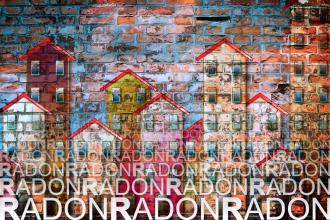Reducing radon exposure in British Columbia
Radon is a colorless, odorless radioactive gas.
What is radon?
Radon is a colorless, odorless radioactive gas. It forms naturally from the decay of uranium in soil and can enter buildings and accumulate in indoor air.[1] As inhaled radon gas irradiates the lining of the lungs, exposure to radon increases the risk of lung cancer.[2] The current Canadian guidelines, established in June 2007, recommend remedial measures to reduce radon exposure when average annual radon concentration exceeds 200 becquerels per cubic metre (Bq/m3).[3]
Health Canada estimates that approximately 16% of lung cancer cases in Canada are due to radon exposure leading to about 1900 deaths each year.[3] A recent Ontario study suggests that radon accounts for about 850 lung cancer deaths each year in that province.[4]
Mitigating radon exposure
Radon exposure can be mitigated through the use of a soil depressurization system. This system consists of a gas-permeable layer of coarse granular material below the basement of the building and an externally venting pipe that is inserted through the basement floor into the gas-permeable layer. Radon gas can then move directly from beneath the basement to the outdoors without collecting in the basement.[5]
Radon exposure and mitigation in BC
In BC radon exposure is of particular concern east of the Coast Mountains in the Interior. In 2007 the British Columbia Centre for Disease Control (BCCDC) measured radon in over 1300 homes and 375 schools across the province. Nine regions had more than 10% of homes with levels above the 200 Bq/m3 level, and three regions (Barriere, Castlegar, and Clearwater) had more than 30% of homes above that level.[6] Of the tested schools, 31 in the Interior were found to be over 200 Bq/m3 and five were over 750 Bq/m3.[7]
BC has taken steps to reduce radon exposure. In late 2014, the BC Building Code was updated to require the inclusion of a rough-in for a subfloor depressurization system and radon vent pipe in all new buildings in areas with high radon levels. This allows for easier installation of a soil depressurization system should elevated radon levels be detected after the building is constructed.[5]
Updates on efforts to address elevated radon in government-owned facilities such as schools and subsidized housing have not been released. A protocol for radon testing in BC Schools has been developed by the BCCDC;[8] however, the progress of this program has not been published. Similarly, the BC Housing Management Commission has not reported on its efforts to review radon levels in subsidized housing.[9,10] Further testing and mitigation measures, if necessary, in schools and subsidized housing can reduce radon exposure for children, youth, and low-income tenants.
For private homes, it remains the responsibility of homeowners to test for radon levels and install a soil depressurization system if necessary.[5] The BC Lung Association, through the public education program called RadonAware, strives to increase awareness of radon exposure risks and mitigation strategies among homeowners and stakeholders in the construction industry.[11] Testing kits can be ordered through www.radonaware.ca. By encouraging patients to test radon levels in their homes and places of work, physicians can play an active role in reducing the risk of radon exposure in BC.
—Ray Copes, MD
—Alex Summers
hidden
This article is the opinion of the authors and has not been peer reviewed by the BCMJ Editorial Board.
References
1. World Health Organization. WHO Handbook on Indoor Radon: A Public Health Perspective. Geneva: WHO; 2009.
2. Committee on Health Risks of Exposure to Radon (BEIR VI), National Research Council. Health Effects of Exposure to Radon: BEIR VI. Washington, DC: National Academies Press; 1999.
3. Health Canada. Radon. 2014. Accessed 26 October 2016. www.hc-sc.gc.ca/ewh-semt/radiation/radon/faq_fq-eng.php.
4. Cancer Care Ontario, Ontario Agency for Health Protection and Promotion. Environmental Burden of Cancer in Ontario. Toronto, ON: Public Health Ontario; 2016.
5. Government of British Columbia. Updates to BC Building Code take effect in December. 2014. [Online]. Accessed 26 October 2016. https://news.gov.bc.ca/stories/updates-to-bc-building-code-take-effect-i....
6. British Columbia Centre for Disease Control. Radon Gas Measurements in BC Homes. 2007. Accessed 26 October 2016. www.bccdc.ca/resource-gallery/Documents/Guidelines%20and%20Forms/Guideli....
7. British Columbia Centre for Disease Control. Radon in Interior BC Schools. 2007. Accessed 26 October 2016. www.bccdc.ca/resource-gallery/Documents/Guidelines%20and%20Forms/Guideli....
8. British Columbia Centre for Disease Control. Radon Testing in BC Schools Protocol. 2012. Accessed 26 October 2016. www.bccdc.ca/resource-gallery/Documents/Guidelines%20and%20Forms/Guideli....
9. BC Housing. 2016/17–2018/19 Service Plan. February 2016. Accessed 26 October 2016. www.bchousing.org/resources/About%20BC%20Housing/Service_Plans/2016-19_S...
10. BC Housing. 2015/16 Annual Service Plan Report. 2016. Accessed 26 October 2016. www.bchousing.org/resources/About%20BC%20Housing/Annual%20Reports/2016/2....
11. BC Lung Association. RadonAware. 2016. Accessed 26 October 2016. www.radonaware.ca.

